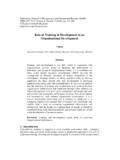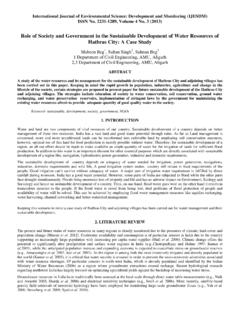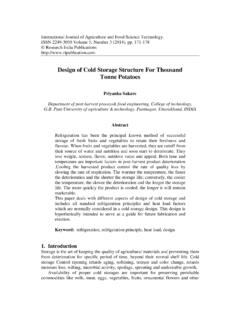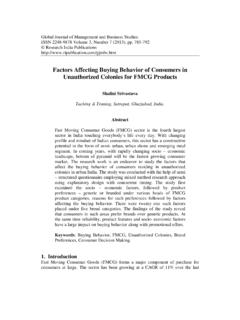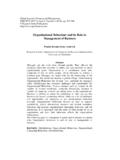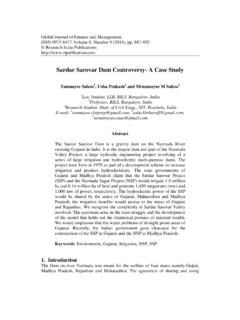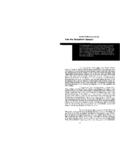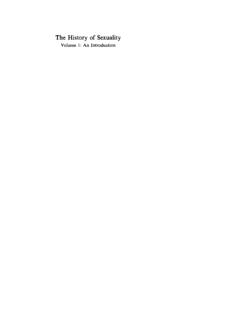Transcription of Common Themes and Techniques of Postmodern Literature of ...
1 International Journal of Educational Planning & Administration. ISSN 2249-3093 Volume 1, Number 2 (2011), pp. 189-198. Research India Publications Common Themes and Techniques of Postmodern Literature of Shakespeare Ramen Sharma and Dr. Preety Chaudhary Research Scholar, Singhania University, Rajasthan, India Postmodern Literature The term Postmodern Literature is used to describe certain characteristics of post . World War II Literature (relying heavily, for example, on fragmentation, paradox, questionable narrators, etc.) and a reaction against Enlightenment ideas implicit in Modernist Literature . Postmodern Literature , like postmodernism as a whole, is hard to define and there is little agreement on the exact characteristics, scope, and importance of Postmodern Literature . However, unifying features often coincide with Jean-Fran ois Lyotard's concept of the "metanarrative" and "little narrative", Jacques Derrida's concept of "play", and Jean Baudrillard's "simulacra.
2 " For example, instead of the modernist quest for meaning in a chaotic world, the Postmodern author eschews, often playfully, the possibility of meaning, and the Postmodern novel is often a parody of this quest. This distrust of totalizing mechanisms extends even to the author and his own self-awareness; thus Postmodern writers often celebrate chance over craft and employ metafiction to undermine the author's "univocation" (the existence of narrative primacy within a text, the presence of a single all-powerful storytelling authority). The distinction between high and low culture is also attacked with the employment of pastiche, the combination of multiple cultural elements including subjects and genres not previously deemed fit for Literature . Background Notable influences Postmodernist writers often point to early novels and story collections as inspiration for their experiments with narrative and structure: Don Quixote, 1001 Arabian Nights, The Decameron, and Candide, among many others.
3 In the English language, Laurence Sterne's 1759 novel The Life and Opinions of Tristram Shandy, Gentleman, with its heavy emphasis on parody and narrative experimentation, is often cited as an early influence on postmodernism. There were many 19th century examples of attacks on Enlightenment concepts, parody, and playfulness in Literature , including Lord Byron's satire, especially Don Juan; Thomas Carlyle's Sartor Resartus; Alfred Jarry's ribald 190 Ramen Sharma and Dr. Preety Chaudhary Ubu parodies and his invention of 'Pataphysics; Lewis Carroll's playful experiments with signification; the work of Isidore Ducasse, Arthur Rimbaud, Oscar Wilde. Playwrights who worked in the late 19th and early 20th century whose thought and work would serve as an influence on the aesthetic of postmodernism include Swedish dramatist August Strindberg, the Italian author Luigi Pirandello, and the German playwright and theorist Bertolt Brecht. In the 1910s, artists associated with Dadaism celebrated chance, parody, playfulness, and attacked the central role of the artist.
4 [clarification needed] Tristan Tzara claimed in "How to Make a Dadaist Poem" that to create a Dadaist poem one had only to put random words in a hat and pull them out one by one. Another way Dadaism influenced Postmodern Literature was in the development of collage, specifically collages using elements from advertisement or illustrations from popular novels (the collages of Max Ernst, for example). Artists associated with Surrealism, which developed from Dadaism, continued experimentations with chance and parody while celebrating the flow of the subconscious mind. Andr Breton, the founder of Surrealism, suggested that automatism and the description of dreams should play a greater role in the creation of Literature . He used automatism to create his novel Nadja and used photographs to replace description as a parody of the overly-descriptive novelists he often criticized. Surrealist Ren Magritte's experiments with signification are used as examples by Jacques Derrida and michel foucault .
5 foucault also uses examples from Jorge Luis Borges, an important direct influence on many postmodernist fiction writers. He is occasionally listed as a postmodernist, although he started writing in the 1920s. The influence of his experiments with metafiction and magic realism was not fully realized in the Anglo-American world until the Postmodern period.[1]. Comparisons with modernist Literature Both modern and Postmodern Literature represent a break from 19th century realism. In character development, both modern and Postmodern Literature explore subjectivism, turning from external reality to examine inner states of consciousness, in many cases drawing on modernist examples in the "stream of consciousness" styles of Virginia Woolf and James Joyce, or explorative poems like The Waste Land by T. S. Eliot. In addition, both modern and Postmodern Literature explore fragmentariness in narrative- and character-construction. The Waste Land is often cited as a means of distinguishing modern and Postmodern Literature .
6 The poem is fragmentary and employs pastiche like much Postmodern Literature , but the speaker in The Waste Land says, "these fragments I have shored against my ruins". Modernist Literature sees fragmentation and extreme subjectivity as an existential crisis, or Freudian internal conflict, a problem that must be solved, and the artist is often cited as the one to solve it. Postmodernists, however, often demonstrate that this chaos is insurmountable; the artist is impotent, and the only recourse against "ruin" is to play within the chaos. Playfulness is present in many modernist works (Joyce's Finnegans Wake or Virginia Woolf's Orlando, for example) and they may seem very similar to Postmodern works, but with postmodernism playfulness becomes central and the actual achievement of order and meaning becomes unlikely.[1]. Common Themes and Techniques of Postmodern Literature 191. Shift to postmodernism As with all stylistic eras, no definite dates exist for the rise and fall of postmodernism's popularity.
7 1941, the year in which Irish novelist James Joyce and English novelist Virginia Woolf both died, is sometimes used as a rough boundary for postmodernism's start. The prefix "post", however, does not necessarily imply a new era. Rather, it could also indicate a reaction against modernism in the wake of the Second World War (with its disrespect for human rights, just confirmed in the Geneva Convention, through the atomic bombings of Hiroshima and Nagasaki, the Holocaust, the bombing of Dresden, the fire-bombing of Tokyo, and Japanese American internment). It could also imply a reaction to significant post-war events: the beginning of the Cold War, the civil rights movement in the United States, postcolonialism (Postcolonial Literature ), and the rise of the personal computer (Cyberpunk fiction and Hypertext fiction).[2][3][4]. Some further argue that the beginning of Postmodern Literature could be marked by significant publications or literary events. For example, some mark the beginning of postmodernism with the first publication of John Hawkes' The Cannibal in 1949, the first performance of Waiting for Godot in 1953, the first publication of Howl in 1956 or of Naked Lunch in 1959.
8 For others the beginning is marked by moments in critical theory: Jacques Derrida's "Structure, Sign, and Play" lecture in 1966 or as late as Ihab Hassan's usage in The Dismemberment of Orpheus in 1971. Brian McHale details his main thesis on this shift, although many Postmodern works have developed out of modernism, modernism is characterised by an epistemological dominant while postmodernism works are primarily concerned with questions of ontology.[5]. Post-war developments and transition figures Though postmodernist Literature does not refer to everything written in the Postmodern period, several post-war developments in Literature (such as the Theatre of the Absurd, the Beat Generation, and Magic Realism) have significant similarities. These developments are occasionally collectively labeled " Postmodern "; more commonly, some key figures (Samuel Beckett, William S. Burroughs, Jorge Luis Borges, Julio Cort zar and Gabriel Garc a M rquez) are cited as significant contributors to the Postmodern aesthetic.
9 The work of Jarry, the Surrealists, Antonin Artaud, Luigi Pirandello and so on also influenced the work of playwrights from the Theatre of the Absurd. The term "Theatre of the Absurd" was coined by Martin Esslin to describe a tendency in theatre in the 1950s; he related it to Albert Camus's concept of the absurd. The plays of the Theatre of the Absurd parallel Postmodern fiction in many ways. For example, The Bald Soprano by Eug ne Ionesco is essentially a series of clich s taken from a language textbook. One of the most important figures to be categorized as both Absurdist and Postmodern is Samuel Beckett. The work of Samuel Beckett is often seen as marking the shift from modernism to postmodernism in Literature . He had close ties with modernism because of his friendship with James Joyce; however, his work helped shape the development of Literature away from modernism. Joyce, one of the exemplars of modernism, celebrated the possibility of language; Beckett had a 192 Ramen Sharma and Dr.
10 Preety Chaudhary revelation in 1945 that, in order to escape the shadow of Joyce, he must focus on the poverty of language and man as a failure. His later work, likewise, featured characters stuck in inescapable situations attempting impotently to communicate whose only recourse is to play, to make the best of what they have. As Hans-Peter Wagner says, "Mostly concerned with what he saw as impossibilities in fiction (identity of characters; reliable consciousness; the reliability of language itself; and the rubrication of Literature in genres) Beckett's experiments with narrative form and with the disintegration of narration and character in fiction and drama won him the Nobel Prize for Literature in 1969. His works published after 1969 are mostly meta-literary attempts that must be read in light of his own theories and previous works and the attempt to deconstruct literary forms and genres.[..] Beckett's last text published during his lifetime, Stirrings Still (1988), breaks down the barriers between drama, fiction, and poetry, with texts of the collection being almost entirely composed of echoes and reiterations of his previous work [.]

